M. Isidora Forrest's Blog, page 8
August 25, 2024
Isis Risen
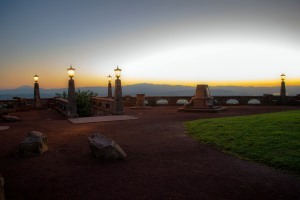 Sunrise at the “castle” at the summit of Rocky Butte, our Sirius Rising viewpoint
Sunrise at the “castle” at the summit of Rocky Butte, our Sirius Rising viewpointWell, once again, Portland weather foiled my plans for watching the Star of Isis rise last Thursday.
But I have some amazing folks coming today to talk about our summer solstice festival for next year: The Return of the Wandering Goddess—so I need to get ready for them.
For today then, instead of a new post, I’m reposting a report from a time when Portland did not foil my Sirius rising plans.
There’s always next year!
Wonderful, wonderful.
That’s not what I was thinking when the alarm went off at 3:20 this morning, but it is exactly what I’m thinking now.
I have just come back from witnessing the rising of Sirius, the Star of Isis, in the morning skies over the city of Portland, Oregon. And it was glorious. A fellow priestess of Isis and I traveled to one of the high places in the city to watch Her be born from between the thighs of Her mother Nuet.
Our vantage point is known as Rocky Butte. It is an extinct volcanic cinder cone that rises to an elevation of 612 ft. within the city limits and is a less-than-ten-minute drive from my house. At its summit, there’s a city park surrounded by castle-like walls, which is a popular viewpoint for visitors and natives alike. From Rocky Butte, you can see the slow serpent of the Columbia river that forms the border between Oregon and Washington and the layered silhouettes of the ranges of the eastern mountains, including the archetypal, snow-capped presence of Mt. Hood (though I prefer its Native American name, Wy’east).
When we arrived shortly after 4 am, we could see Orion-Osiris clearly, so we seated ourselves before Him to await Her Rising. We brought stargazer lilies, bread, and milk to offer to Her at Her Appearance, and we each also had that wonder-working wand of modern priestesses, a phone equipped with Google Sky so we could check Her progress toward the horizon. Even though the morning was clear enough, with the haze of the city lights on the horizon, we weren’t certain we’d be able to see Her, but we settled in to wait.
 This is what we saw in the pre-dawn sky
This is what we saw in the pre-dawn skyThen, to the far left of where the Goddess’ star would rise, we noticed something strange and beautiful. It turns out that this was the one and only morning to see another pre-dawn cosmic wonder: a perfect triangle in the indigo sky of Jupiter, Venus, and the slimmest crescent of the waning Moon. As the triad rose higher in the sky, the crescent turned from ruddy orange to milk white and, from our viewpoint, framed a small stand of fir trees before us on the Butte. It was spectacular. I’ll take that as a portent for the New Year anytime.
At just about 5 am, Google Sky told us Iset-Sopdet should be above the horizon, but we still couldn’t see Her for the city lights, haze, and mountains.
Then—wait, what’s that? Yes, we could see something flashing through the haze, shooting off sparks of red and white and blue-green: Iset-Sopdet appeared. She scintillated. She glittered. She sparkled.
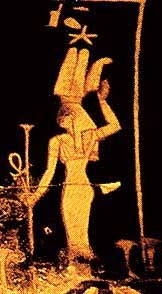 Iset-Sopdet
Iset-SopdetWe watched Her Rising in silence, but for the sounds of the night and the coming dawn.
We meditated, each in our own way. Then, after a time, we poured the milk, offered the bread, and placed the vase of stargazers on the surrounding wall so that they were in alignment with Her star. I really hope someone finds them later today and takes them home to enjoy the incredible fragrance of those lilies. She, I am sure, has already enjoyed them.
The heliacal rising of Sirius, August 23, 2014, was for me, quite simply, a perfect experience.
She is risen.
August 18, 2024
Who is the Goddess Neotera?
 The Ptolemaic Queen Berenike II as Isis-Aphrodite
The Ptolemaic Queen Berenike II as Isis-AphroditeStarting in the late-Ptolemaic period, we begin to hear of a Goddess called Neotera or Thea Neotera, the “Younger One” or the “Younger Goddess.” She’s a bit enigmatic because researchers aren’t sure exactly Who (or even who) She (or she) is.
Egyptologists have made a number of suggestions as to Her identity. Some identify Her as a Goddess, while others say she is a deified queen. (Hence my earlier capitalization ambiguity.)
 A coin with Kleopatra Thea Neotera
A coin with Kleopatra Thea NeoteraLet’s look at the deified queen part first. Because that deified queen was most likely to have been Kleopatra VII; yes, THAT Kleopatra, the last of the Ptolemies, last ruler of an independent Egypt.
The Ptolemaic queens were into identification with Goddesses, Isis and Aphrodite being their top picks. Kleopatra, as mother of baby pharaoh Ceasarion, claimed for herself the title Nea Isis, “the New Isis.” What’s more, there actually were coins of the time bearing her image and the title of Thea Neotera. These were made by Kleopatra and Marcus Antonius for places outside of Egypt and meant to bolster her image in the greater world.
 Isis-Kore-Persephone with Hades and His hound Kerberos/Cerberus
Isis-Kore-Persephone with Hades and His hound Kerberos/CerberusIn Egypt, as you know, it was not unusual for there to be funerary cult maintained for rulers after their death and so we learn of a “great Kleopatreion” surviving at Rosetta (40 miles east of Alexandria, where the Rosetta Stone was found) into the 4th or 5th century CE. Alexandria was particularly resistant to Roman rule and it seems likely that, as Egypt’s last ruler, Kleopatra would have become popular with the people and her cult kept for long after her death. So Neotera certainly was Kleopatra VII in some instances.
 Close up of Isis Kore with sistrum
Close up of Isis Kore with sistrumBut that is by no means the end of this quest.
Let’s move over to the Goddess side of the ledger. When Demeter and Persephone (also called Kore, “the Girl”) are named together, Kore is sometimes given the title Thea Neotera. She is the Younger Goddess in comparison with Her mother Demeter. Alexandria had a very famous festival of Kore, duly groused about by the Christian polemicist Ephiphanius. You can read his grouse here; you’ll need to scroll down. At Her temple at Denderah, the Great Goddess Hathor is called Aphrodite Thea Neotera (recall that this is a mostly Ptolemaic temple).
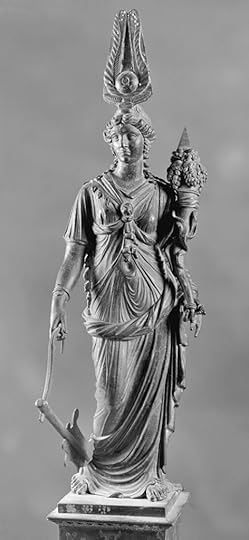 Isis Tyche with Isis knot, rudder, and cornucopia
Isis Tyche with Isis knot, rudder, and cornucopiaYet we also find all these Goddesses as separate Beings. In one of the many papyri found preserved in the trash dump in the Egyptian city of Oxyrhynchus, we have a document that records the return of certain temple properties in which we learn that Oxyrhynchus had separate temples to Kore and to Neotera. Among the Neotera temple goods was a bronze statuette of Neotera as well as a rudder that was one of Her symbols.
So that’s a bit of a clue about Neotera’s nature. The rudder makes Her a guiding Goddess. We also have a small gemstone with an inscription on both sides. On the obverse, the inscription refers to Sarapis. On the reverse, the inscription is “Great Fortune of the Invincible Neotera.” And so Neotera is also associated with good fortune. Since Fate and Fortune were considered to be “invincible” powers, our Goddess Neotera must be even more invincibly powerful as the one Who rules them.
Now, since the gem also has Sarapis on it, Isis would be a good candidate for Neotera; Sarapis is Her consort in this period. And one of Isis’ sacred symbols is indeed the rudder. Plus, as Isis-Tyche and Agathetyche, She is well known as the Lady of Fate and Good Fortune. But, Isis is not usually considered the younger one. In the Egyptian myth, She is, in fact, the older sister.
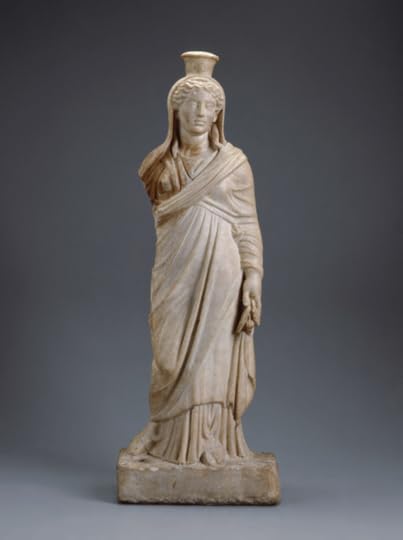 Isis Demeter
Isis DemeterFrom Gerasa, modern Jordan, we have an inscription that accompanies an image of Zeus-Helios-Great Sarapis, Isis, and Neotera. The article I’m reading wonders whether Neotera here is Hathor-Aphrodite or Nephthys, but then rejects both options. Yet, it seems to me that Nephthys is a good option here. The combined God Zeus-Helios-Sarapis is common at that time and the God Sarapis is a later development from Osiris. It would be natural to have Isis and Neotera-Nephthys with Him.
A later grousing Christian, Athanasius, complains that Isis, Kore, and Neotera were human women who became deified “among the Egyptians.” So, for Athanasius at least, Neotera is known to be Egyptian, though Her name/epithet is Greek. And She is separate from Isis and Kore. An Italian Egyptologist, L. Moretti, (and some others, but I’m still looking for those) has indeed suggested that Neotera was a Greek interpretation of Nephthys. And while I like the idea that Gerasa’s Neotera might be Nephthys, it would have been quite unusual for Nephthys to be among the exported “Egyptian Gods” at that time. When people outside of Egypt referred to the Egyptian Gods then, they meant specifically Isis, Sarapis, Anubis, and Harpokrates.
 Isis, Nephthys, and the Osiris (the dead person)
Isis, Nephthys, and the Osiris (the dead person)A scholar of Hebrew texts notes that a cult of Neotera-Isis was practiced in Roman Palestine—and the people there would also have been exposed to the prior Kleopatra Thea Neotera coins. He further notes that the worship of Isis was to be found in Israel at Raphia, Gaza, and Ashkelon. According to a rabbinical text, however, if you should happen to find evidence of that worship—such as an image of a breastfeeding woman, a ring with a moon or Sarapis on it—you were supposed to take it and toss it into the Dead Sea. (Let’s excavate!)
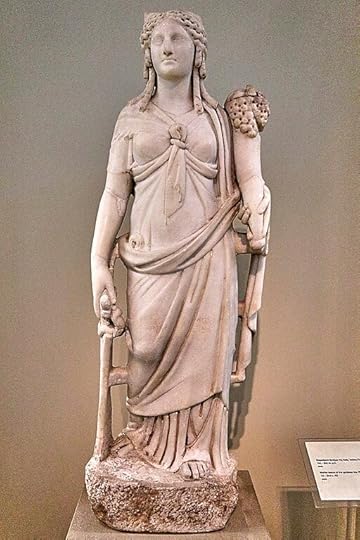 Isis Tyche with Isis Knot, rudder, and cornucopia
Isis Tyche with Isis Knot, rudder, and cornucopiaSo, now I must come to the disappointing conclusion that, except where we see the epithet Neotera with another name—Kore Neotera or Kleopatra Thea Neotera, for example—we have no definitive answer as to Who the Goddess Neotera is. I thought I was going to be able to identify Her with Isis’ Younger Goddess sister. But so far, there’s just not enough evidence. Some scholars have suggested that, over time, the epithet Neotera got separated from (perhaps) Kleopatra’s Thea Neotera epithet and eventually became a separate Goddess; an egregore Goddess, we might say?
Yet our best clue as to Her nature still comes from the rudder symbol and the gemstone naming Her as Fortune. Thus, we can invoke Neotera for Good Fortune and for steering our lives in the right direction with Her wise rudder.
But, of course, we already have a Goddess Who just happens to also cover those areas: Isis, She of the Rudder, Giver of Good Fortune, Ruler of Fate.
August 11, 2024
Worshiping Isis
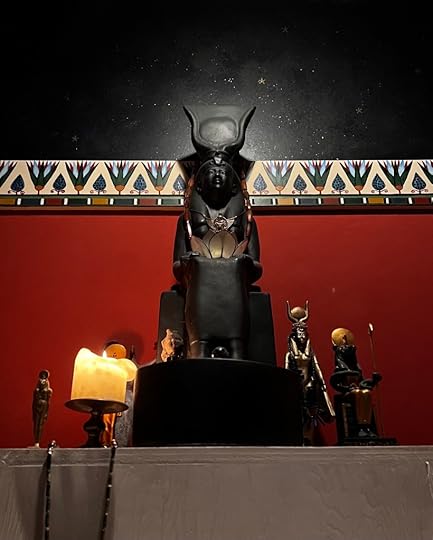
It is morning and quiet here.
I enter Her shrine, light the candles, ignite the charcoal in the censer, pour Nile Water into the cup. The stillness of the morning settles in the shrine and in me. I sit on the floor before Her sacred image, looking up at Her.
“Hello, Isis,” I think to Her. No response. But I do not really expect one. Not yet.
I breathe, slowly, deeply. I focus on my own consciousness, which I sense centered in my head. Then, on a breath, I let my consciousness roll out and out and out, expanding into the unseen world, where She Is, where I can greet Her.
“I am open unto Isis, only Isis,” I whisper into the stillness. I breathe, opening my mind and body and Self to Her.
 The water vessel filled with Nile Water
The water vessel filled with Nile WaterI take up the cup with Nile Water, elevate it. I call out to the Souls—the Bau—of Night asking Them to imbue this water with Their purifying powers in Her name. I envision blue light flowing into the cup. I sense starlight. I feel a slight heaviness in the cup.
I sprinkle water throughout the shrine. East, south, west, north. I sprinkle myself with this ensouled water. I speak the purifying formula, adapted from ancient texts. “Isis is pure, I am pure…” As I breathe in, blue light spirals into my core. As I breathe out, it reverses direction, carrying impurities out with it. I do this until I feel balanced and ready to come before Her in worship.
 A hand-painted censer with lotus flowers
A hand-painted censer with lotus flowersI take up the censer, place incense on the coal. Scented smoke rises. I call out to the Bau of Day asking Them, in Her name, to fill the censer with Their consecrating powers. Red light settles around the censer; its heat increases. I waft the smoke throughout the shrine as before. “Isis is consecrated, I am consecrated…” I coax the scent over my body. I breathe in the red consecration until I am replete, consecrated to Her worship.
I sit. Breathe. Open my consciousness again. I sense Her waiting on the edges of that consciousness.
I raise my hands, beckoning. I speak the very simplest of all the Egyptian invocations I know. “Iu en-i (Eeoouu-en-ee). Iu en-i, Iset,” I say. “Come to me, come to me, Isis.” I repeat this, softly, letting my words, my desire flow out to Her.
And suddenly the shrine is full of wings. Now it feels a bit crowded in here, but I let my ka relax, that it may better touch Hers. She shows Her beautiful face to me. Large, dark, almond eyes. Wide mouth. Long, wide nose. The shrine is full of wings and feathers, impossibly multi-hued. And it is full of Her.
 She has serpents and sistra
She has serpents and sistraI have come to worship, so I ask what She desires. “Your thoughts and offerings help Us abide in Our images [She means the sacred images we obtain and consecrate for Her and for all our Divine Ones] and in your hearts,” She says. “Spend time, make offering.”
She is before/around me now. She begins to breathe through my being. She is concentrating on the shenu—the energy centers—of my third eye and my heart. [I think this means either those centers are the most sensitive in me right now, or perhaps the least sensitive and they need work. I am not sure.] She breathes out, I breathe Her into my centers. Hold. I breathe out, She breathes into Her shenu and holds the power. We do this again and again. “What do you feel?” She asks. “Expansion. Excitement. Connection to You,” I say. “Worshiping is communion,” She says. “Your thoughts of Me are the flowers I choose for My garden.”
 She, with Harpokrates, Werethekau, and the Goddess with Upraised Arms
She, with Harpokrates, Werethekau, and the Goddess with Upraised ArmsI think blue lotuses for Her.
She takes them.
“Look into My eyes,” She says, “into the Black of the Kore.” [She is referring to this.] I do. “Worship begins at the Origin and ends there, too,” She says. “Worship is exchange, energy, offering, love. Worship is being in harmony with. Worship is rising in the Boat of the Morning and setting in the Boat of the Night. Worship is surrender that I may uplift you. Worship is vulnerability before Me, a release of fear. Worship is just love; you for Me, Me for you,” She says.
I sit then, in worship, as I do whenever I enter Her shrine, and whenever I think of Her. I am content. She, I think, is also content.
And that is how it went this time.
August 4, 2024
She Who Rises at the Opening of the Year
 Look down from Orion’s belt; the bright star near the horizon is Sopdet.
Look down from Orion’s belt; the bright star near the horizon is Sopdet.I’ve written a lot on this blog about the heliacal (“before the sun”) rising of the Star of Isis—Sirius in Latin, Sothis in Greek, Sopdet in ancient Egyptian—which marked the beginning of the Egyptian New Year and the return of the life-giving Inundation flood. (You’ll find the basic information on Isis and Her holy star here. For more, just search “Sirius” on this blog.)
When Sirius rises in your area depends on your latitude. For me, in 2024, Her rising is August 22, in the hour before dawn. Thanks to the wonders of modern online astronomical calculators, we can know pretty precisely when the Fair Star of the Waters will rise before the sun. (To use the linked calculator and find out when Sirius rises in your area, just enter your email and the password: softtests. You will need to know the latitude and altitude of wherever you are observing Her rise. This info is easily google-able.)
But for the ancient Egyptians, and for those of us who honor the Ancient Egyptian Deities today, something else happens prior to the rising of Our Lady’s star: the “Five Days Upon the Year” or the epagomenal days. These were five days outside of time that marked the transition from the Old Year to the New Year. These five days, added to the Egyptian 360-day year, brought them up to the requisite 365 (or almost; they were short a quarter-day).
 Sakhemet shooting Her arrows, by Wolchenka. See more art here.
Sakhemet shooting Her arrows, by Wolchenka. See more art here.On these five days, the birthdays of Osiris, Horus (or Horus the Elder), Set, Isis, and Nephthys were celebrated. But this time wasn’t just a happy birthday party for the Deities. This time-outside-of-time, this liminal period, was also a period of great danger. This was the period before the coming of the yearly flood that fertilized Egypt’s fields along the Nile. It was the time of the lowest water; in some places, boats could no longer navigate. All along the Nile banks, everything was drying out. The food stores from last year’s harvests were running low. People were beginning to anticipate—and be anxious about—how high the waters would rise this year. Would there be famine or feast?
To those of us in the Northern Hemisphere, this may feel quite familiar in August. The foliage that used to be lush green has started to look dried out and dusty. Heat sits heavy upon the land. In some places, people are bracing for the possibility of their own high waters from hurricanes. And though my local farmers’ markets are brimming with harvest produce, my social feeds are filling up with people canning and preserving—for we still feel the need to conserve today’s harvest against the coming darker months.
 Our epagomenal Deities, plus (I presume) young Anubis with Nephthys
Our epagomenal Deities, plus (I presume) young Anubis with NephthysFor the ancient Egyptians, the epagomenal days were also the time that Sakhmet sent out Her plague demons to infect the people. Known as the Messengers, Slaughterers, or Arrows of Sakhmet, these frightful Beings struck people down, sickening or evening killing them. There is new research showing that the infamous bubonic plague or Black Death may have originated in Egypt—and indeed that it, or something like it, had been plaguing Egypt for centuries. The Ebers medical papyrus, dated to about 1500 BCE, lists a disease that includes the description of a bubo, an infected lymph node that was characteristic of the bubonic plague.
 An example of the protective amulet with 12 destructive Arrows of Sakhmet shown.
An example of the protective amulet with 12 destructive Arrows of Sakhmet shown.All this is to say that Sakhmet’s Arrows were not to be taken lightly. And people did not. The king and the temples worked to protect Egypt during this time with the rituals of Sehotep Sakhmet, “pacifying” or “satisfying” Sakhmet, for She Who could bring plague could also protect against it. The people themselves wore special amulets and used particular spells to avert the plague, or other calamity, at this time of year.
One amulet listed 12 of Sakhmet’s Messengers “who bring slaughtering about, who create uproar, who hurry though the land.” To make the amulet, you draw Them on a piece of linen, knot it 12 times, and wear it around your neck (one of our most vulnerable spots). Then you repeat a particular prayer regularly from the time you put it on until the New Year. You were also to make offerings of bread, beer, and incense as part of activating the amulet. Archeologists have even found some examples of these linen amulets.
As a great Magician Goddess, Isis is particularly associated with magical knots, especially in relation to protective magic. When an ancient Egyptian referred to a “knot amulet,” what they usually meant was the famous Knot of Isis, one of the amulets that protected the dead. Isis and Nephthys are said to work protective magic for Osiris with knotted cords. Knot magic continues to be a popular form of spellwork today.
 A linen strip with the image of Isis drawn on it. It’s pretty faded, so a sketch of the image is included in the lower left corner.
A linen strip with the image of Isis drawn on it. It’s pretty faded, so a sketch of the image is included in the lower left corner.In addition to this overall protection, there were particular spells and amulets associated with each of the five epagomenal days. Linen amulets, similar to the one already mentioned, featured the image of the Deity Whose birthday was celebrated that particular day. We also have a few examples of these, but not a complete set. On the right is a picture of the one we have for Isis’ birthday; the other two existing ones are for Nephthys and Osiris.
Another reason that the epagomenals were an apprehensive time of year was that normal cyclical time, neheh-time—the yearly changes and renewals, came to a stop. The old year had ended and the new one had not yet begun. Djet-time, perfected unchanging time, took over. Now, you might think perfected time would be good. And it is. Eventually. But not for life on earth. Life here needs the changes of the seasons and the development of the years to survive. For more about neheh and djet time, go here and here.
For me, with the rising of the Star of Isis on the 22nd, the epagomenal days begin on the 17th of August. I plan to honor each of these Great Deities on Their birthdays, perhaps with similar amulets and prayers, and certainly with bread, beer, and incense.
This year, I am definitely feeling the unsettled liminality of the approaching epagomenal days. It has much to do with the political situation here. I have renewed hope that with the rising of the Star of Isis later this month—and with Her even more brilliant position in the night sky in…oh, let’s say, November…that Ma’et will prevail. But we don’t yet know how high the river will rise. And so we work toward Ma’et, we do our civic duty—perhaps do some protective magic with Isis as well—and we wait.
July 28, 2024
The Night Isis Accepted Me
This week got away from me.
I’ve been working on some new material for the new edition of Isis Magic (yay!). But that means I didn’t get to the post I was planning for today—some juicy tidbits about Isis in Rome (She’s still there, of course).
Instead I’m reposting the story of when I knew Isis had accepted me. I’d love to hear you story, too. Please do share in the comments, if you’d like.
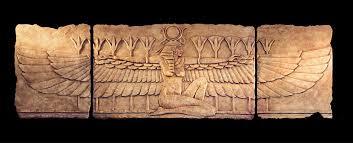 Wings and lotuses, always
Wings and lotuses, alwaysI am terrible with memories. I don’t mean my memory is bad. I mean I don’t honor ‘things past’ enough. I don’t take many pictures (and certainly not of myself). I tend not to care for traditional souvenirs. And I definitely have the “get rid of it” gene (which my beloved does not). In my defense, I don’t generally dwell on past wrongs either.
Earlier this week, this post was going to be on an entirely different topic. But then I came across an old magical journal. And there were memories in it.
 Not my magical journal, but I like…
Not my magical journal, but I like…I do keep magical journals. I don’t record everything all the time (good Goddess, the paper trail would never end!). Usually, I keep them during periods when I’m doing a lot of magical work. This particular journal, as I have said, is old. I mean really old. Like “before the fire” old. Yes, of course, you don’t know what I mean.
Before we moved to the Pacific Northwest, we lived in an apartment in Tennessee. One night the complex caught on fire. Neighbors knocked on neighbors’ doors, telling them to get up and get out. We grabbed the cat and the insurance papers and got out. The next day, with the fire quenched, we were able to go back to survey the damage. It had been a weird fire. Things like our stereo system were completely and utterly incinerated. Things like our irreplaceable magical papers (papers!) were saved. This journal was among them. I can tell from the singed edges.
So I thought I’d sit down and read it. There was lots of visionary work pertaining to a magical system I was training in. But every now and then, there were entries about Isis. This was before I knew very much about Her, before I became Her priestess, and way before Isis Magic. Yet I clearly had been working with Her (or She was working with me).
 A magical, glowing blue lotus
A magical, glowing blue lotusOne entry reads, “I have had a very strong Isis connection since my dream the other night.” That dream was not recorded, but a vision was. I was working on love and acceptance. For the vision, I called on Isis to touch me and help me let Her love of humanity come through me. I sensed Her great, but gentle hand descend from above. She placed it on top of my head. Waves of Her not-quite-orgasmic love passed though me and out into the world. I describe that flow of energy, then write, “I again saw the bright, bright, blue glowing lotus.” It had been so bright that I couldn’t tell one petal from another; eventually, the lotus-light enveloped me. I conclude, “I am feeling very worshipful of Great Isis.”
I see myself falling in love with Her through this journal.
Another entry says, “A most wondrous dream! A prayer answered!” Apparently, my beloved was snoring, so I took my bedding and went into our temple room to sleep. I was overcome with a desire to know, truly know, that Isis was with me. I write that it was “a demanding, revealing need” for Her presence. I prayed to Her “more emotionally than ever before” to send a dream to let me know She was with me. I chanted Her name for a while, then slept.
 This art was inspired by a dream the artist had of the Temple of Isis in Pompeii. See what her dream was and more of her work here.
This art was inspired by a dream the artist had of the Temple of Isis in Pompeii. See what her dream was and more of her work here.“A few hours later,” I write, “I came from a full, deep sleep to awake with loud sobbing from happiness and amazement.” (My sobbing.) Due to the abrupt awakening, I lost part of the dream. But the actual content of the dream wasn’t the point. The point was that, in the dream, the resolution to a dream-problem happened by a miracle. By Her miracle. And it made me so happy that I woke up crying with joy. And I again saw the blue lotus flower.
 Woman picking blue lotus
Woman picking blue lotusI remember this event. The details are a bit fuzzy now, but I vividly remember the visionary blue lotus. I could see it anytime I closed my eyes with crystal clarity instead of the vague dreaminess that vision often has. “I must look up lotus symbolism and I must make a blue lotus talisman,” I wrote. See how much I didn’t know then? Another entry says simply, “I love Her.” And now you know why the Isis temple in my backyard is called the Lotus Temple.
Next, I found an entry that I had marked IMPORTANT with a drawing of a star, a lotus, and a sickle on top. I wrote, “In the dark month of February, on the 15th of the month, with the moon waning in Capricorn, I have taken and been taken by Isis in Her Black Aspect as my Lady, my personal Goddess.” But this wasn’t when I became Her priestess; that was long in the future then. This was my forming a true bond with Her, a bond that will last my entire life. She became “my” Goddess, I became Her devotee. This is when I really began learning about Her.
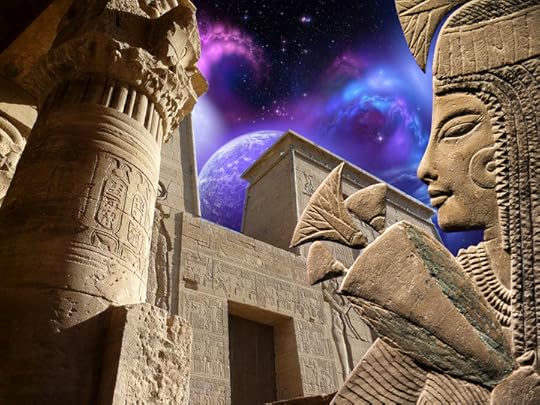 A priestess by Winged Isis; see more work here.
A priestess by Winged Isis; see more work here.There is, of course, more in this journal. I see my own inner struggles, doubts, fears, angers, and depression. But this particular record is incomplete. These are loose-leaf pages without a binder…and it seems that some are missing. After we moved to Portland, I began buying blank-but-bound books for my journals. The next one—which I am still writing in—starts with the time when I actually did become Isis’ priestess. In this journal, I can see that I am working out the magic part for what will eventually become Isis Magic.
But I think I have regaled you with quite enough of my journal entries for now. And I have learned my lesson that I should better value memories and keepsakes. Perhaps you will do some magical work with Isis yourself today? After all, your story will be a much better tale—because it will be yours. Just don’t forget to write in your journal.
July 21, 2024
Nuet, Mother of Isis, Mother of Stars

Right now, I am in a state of anticipation.
As I look to the night sky, I cannot see the star of Isis, Sirius, for She remains hidden now. Yet I anticipate Her rising late next month. But in the meantime, I contemplate the vastnesses of Her mother, Nuet, the Sky Goddess, Who is filled with the Indestructible Stars that Are in Her, and within Whom Her daughter now rests.
 A most beautiful Nuet
A most beautiful NuetI am not Nuet’s priestess, but O, the Secret One draws me. I am awed by Her Eternity, Her Depth, Her Beauty, and I want to lose myself in Her. And right now, in the northern hemisphere at least, Our Lady Isis is Herself lost within the beautiful body of Her mother Nuet.
Right now, the star of Isis, Sirius, is hidden. Here in Portland, Oregon, She will not be seen again until pre-dawn in late August. Astronomically, that’s because the star is in conjunction with the sun. As the sun rises, its greater light makes the light of Sirius invisible to us. By late August, Sirius and the sun will move further away from each other so that, just before dawn, we can once more see the brilliance of the star in the twilight sky.
But that’s just astronomically. Mythically, Isis sojourns within the body of Her powerful mother Nuet. She Who is called the Mistress of All and the One Who bears the Gods and Goddesses. She is the Splendid and Mighty One in the House of Her Creation. She is the Great One in Heaven and the Indestructible Stars, that is, the circumpolar stars that are always visible, are within Her, just as Her mighty daughter Isis is within Her.
Nuet embraces the deceased king and each of us “in Her name of Sarcophagus” and “in Her name of Tomb.” She is the Mistress of the Secret Duat (the Otherworld). She is the Glowing One (perhaps as the Milky Way) and in Her we are joined to our stars, Becoming Divine. She is the one Who gives birth to us and Who welcomes us back into Her starry body at our deaths. She is Heaven and She is the Otherworld. She gives birth to the Sun God Re each day and receives him back into Her body, by swallowing, each night. She is the one Who is “Amid the Iset Temple in Dendera” for She is over Her daughter and Her daughter is in Her.
But now, while Isis is in Her mother’s body, She is also in the Underworld—for Nuet is the Lady of the Duat and Her body is both the Heavens and the Underworld. So now in the heat of the year, our Goddess is in the cool depths of Eternity. Perhaps this is the time for us, as Her devotees, to enter the Otherworld as well.
 Nuet, the Circle of Eternity, encompassing All
Nuet, the Circle of Eternity, encompassing All Sopdet (Sirius), the Star of Isis
Sopdet (Sirius), the Star of IsisWe usually think of symbolically going into the Underworld during the dark part of the year rather than the light part. Yet now, in the light of summer, it may be a particularly safe time to take that Underworld journey, for now we have the support of Isis Who awaits us there.
If we have scary things to face in our own personal Underworlds, now is a more supportive time to do so. The light of dawn comes more quickly now and the sunlight of Isis the Radiant One is more readily available to us after we have faced those inner darknesses that we must face in order to grow.
This may also be a good time to explore our relationships with our mothers. A strong priestess of my acquaintance, who was serving as a Priestess of Nuet at a festival a while ago, told me an interesting thing about how she perceived the relationship between Nuet and Isis. It was her distinct impression that Nuet did not get along with Her daughter. Of course, in the human realm, this is far from an uncommon thing. Mothers and daughters (and mothers and all their children, for that matter) can have issues. Now—in the light of summer and with the help of the Goddesses available to us—now might be a time to shed some light on those issues.
 Sarcophagus lid with Nuet opening Her protective wings over the deceased
Sarcophagus lid with Nuet opening Her protective wings over the deceasedBut even if we don’t have mom stresses, this can be a time to honor and remember our mothers, both human and Divine—perhaps under a star-filled sky. Since my own mother has already been enfolded in the wings of Isis, I shall plan to honor my Divine Mother Nuet and Her Starry Daughter Isis as I look up into the next clear and star-filled night.
July 14, 2024
The Great Mother & Her Mother & Her Mother’s Mother
Lately, I am thinking about the stars.
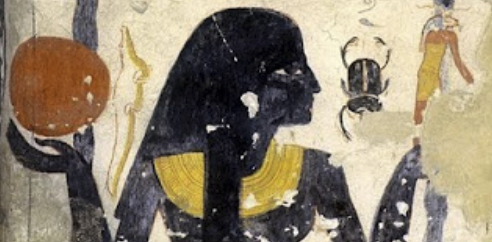 Nuet, mother of Isis holding the sun
Nuet, mother of Isis holding the sunWith our hot weather, the night skies are clear now, so when I look up, I can see the body of beautiful, star-filled Nuet, the mother of Isis. A little while ago, a friend of this blog asked a very interesting question about Her…and Her. “How we can reconcile the idea that Isis is both Mother of All with the idea that Isis has a mother Herself,” they asked.
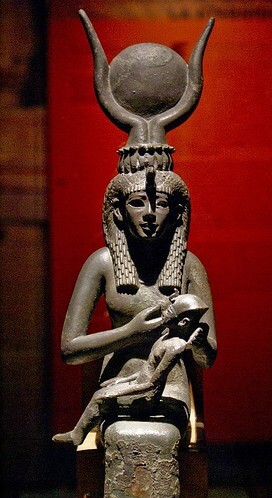 Isis the Mother
Isis the MotherIt’s a very interesting question because it has to do with our conception of the nature of the Divine and Divine Beings in general.
So how do we start to look at this?
For me, history is always a good place to begin. It gives us a useful foothold to know what our ancestors thought about these things; after all, when it comes to Divinity and Divine Beings, we human beings have been thinking about this for a very long time indeed.
Erik Hornung’s Conceptions of God in Ancient Egypt, the One and the Many is one key text for understanding the nature of the Divine in terms of ancient Egypt. Hornung writes that the Egyptians had a multiplicity of approaches to the Divine and only when taken together can we see the whole picture. For them, he says, everything came from One because the non-existent is One, Undifferentiated Thing. Once something becomes existent, it also becomes multiple.
 Atum arises from the Nun, the primordial waters of No-Thing-Ness
Atum arises from the Nun, the primordial waters of No-Thing-NessWe see this in the Heliopolitan myth in which Atum comes forth from the Nun, the non-existent, the inert, and immediately begins generating other Deities through an act of masturbation: first Shu and Tefnut, Who beget Nuet and Geb, Who beget Isis, Osiris, Set, and Nephthys.
And so we meet Isis, Her mother Nuet, and Her mother’s mother Tefnut. And there may even be a great grandmother present, for when Atum came into existence, He was both masculine and feminine; His “shadow” or “hand” (the one He used to masturbate) is the Goddess Iusaaset or Iusâas. She is usually represented anthropomorphically, through, and not as a disembodied hand, and She is said to be the Grandmother of All the Gods.
 The Ennead of Heliopolis
The Ennead of HeliopolisAnother important characteristic of the Divine in ancient Egypt is Its fluidity. Hornung says of the Egyptian Deities, “They are formulas rather than forms, and in their world, one is sometimes as if displaced into the world of elementary particles.” Deities may be combined with one another or split off from one another; one Deity can be the ba—soul or manifestation—of another; They can even be assimilated with foreign Deities without losing Their essence. “But wherever one turns to the divine in worship, addresses it and tends to it in cult” Hornung writes, “it appears as a single, well-defined figure that can for a moment unite all divinity within itself and does not share it with any other god.”
 Isis protected by the Vulture Mother
Isis protected by the Vulture MotherThe primordiality and uniqueness of Isis is attested on the Great Pylon of Her graceful temple at Philæ. The Ptolemaic passage states that Isis “is the one who was in the beginning; the one who first came into existence on earth.” In the Coffin Texts, Isis is invoked with a group of Deities considered to be the most ancient: “O Re, Atum, Nu, Old One, Isis the Divine…” (Formula 1140). She is called Great Goddess Existing from the Beginning, Great One Who Initiated Existence, and Great One Who Is From the Beginning. Her very name, Iset or Throne, speaks to Her ancient nature.
By the time of the New Kingdom, Isis is routinely called Mother of All the Gods. Then, with Her worship spreading throughout the Mediterranean and beyond, Apuleius can write that Isis “brings the sweet love of a mother to the trials of the unfortunate,” while a Latin dedicatory inscription sums up Her all-encompassing nature: Tibi, Una Quae es Omnia, Dea Isis, “Thou, Being One, Art All, Goddess Isis.”
So now we have ancient attestations both of Isis’ ancient and original one-ness and of Her generation from Her parents, grandparents, and great grandparents. How do we resolve it?
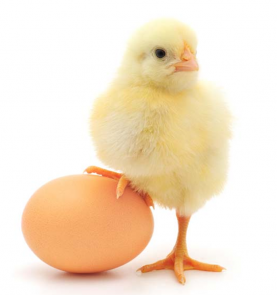 Which came first? It’s a paradox.
Which came first? It’s a paradox.If we are among those who are uncomfortable with paradox, I’m afraid there may be no satisfying reconciliation between these two ideas. If it has been deeply ingrained that there can only be one right answer—especially when it comes to spiritual questions—then it may seem impossible for both these things to be true. After all, they contradict each other. At the very least, we should be able to pick one as the “right” answer. At the very most, we may decide the contradiction means both things must be false.
And yet we have already seen that, at least to the ancient worshipers of Isis, both things were indeed true.
This is what paradox is; and religion is absolutely rife with it. Why? Because most religions, or spiritualities, involve Mystery. Mystery is at the very core of the Divine and paradox is one of Its favorite languages. Yet this is not to say we should simply throw up our hands up and say, “Goddess works in mysterious ways” and quit thinking about it.
Quite the opposite in fact. Paradox invites thought. It is intended to teach. So what can we learn from our paradox: Isis is Mother of All, yet She Herself has a mother…and a mother’s mother…and?
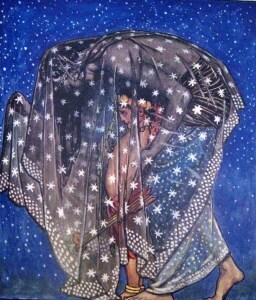 Originally an illustration for a book of pseudo-Indian love poetry called The Garden of Kama, this lovely illustration by Byam Shaw, 1914, captures something of Nuet caring for one of Her Holy Children
Originally an illustration for a book of pseudo-Indian love poetry called The Garden of Kama, this lovely illustration by Byam Shaw, 1914, captures something of Nuet caring for one of Her Holy ChildrenLet’s look at it through that ancient Egyptian lens that shows us a multiplicity of approaches to the Divine.
One way we can approach is through the Heliopolitan myth does: Isis is part of a Divine family. By being so, perhaps She is better able to understand human beings when we come to Her with our own familial problems. Her family relations make Her more suited to be a Soteira, a Savior Goddess, as She was known throughout the Mediterranean world.
We can also learn some important things about Isis through Her family relations. Isis is the daughter of Heaven (Nuet) and Earth (Geb). She is married to the Underworld God, Osiris, and is Herself a Goddess of the Underworld. Thus Isis is intimately connected to All That Is; She walks in all the Worlds.
Another approach to our paradox is through the fluidity of the Egyptian Deities that we talked about. If They can combine or split at will, or if one can become the ba of another, why can’t Isis be at once a Great Mother Herself and the daughter of a Great Mother?
Yet another approach is to open our hearts toward Isis in worship and experience Her for ourselves. Then, as Erik Hornung explained, Isis “appears as a single, well-defined figure that can for a moment unite all divinity” within Herself; She is the One Who is All, and She is the Mother of All.
By combining these approaches, and tolerating a little paradox, we learn more about Isis than we ever would have by restricting ourselves to a single position alone and Isis reveals Herself ever more as the Great Goddess She is.
 Isis is all things and all things are Isis
Isis is all things and all things are Isis
July 7, 2024
Touching Your Isis Star
It’s hot here, as it is in so much of the US and across the middle latitudes. But in the often-cloudy pacific northwest, there is a benefit. It’s the night. O, in the night, the sky is clear and we can finally see the brightly shining stars. And so today, whether you can see the stars at night or not, I offer you this meditation on your own unique star, the Star of Your Soul, the Star of Your Self. If you want to know more about the background of this star, have a look at this post.

The Rite of Touching Your Star
Contemplate the image of the stars above or remember how the night sky looked the last time you stargazed. Purify and consecrate yourself using the formulae of the House of Isis, or use any method that you usually use to prepare yourself for ritual.
Facing east, raise your arms in the Sign of the Wings of Isis and say:
Ritualist: Iset Sopdet, Daughter of the Stars, Queen of Souls, I have come to You that You may help me to find and to touch the light of my own Beautiful Star, my own Divine Light. Amma, Iset, let it be so.
Continuing to face east, be seated comfortably, close your eyes, and breathe deeply and slowly for several minutes. When you are ready, visualize the following:
Imagine that you stand before the great pylon gates of an ancient Egyptian temple of Isis. It is late evening. The sky is a luminous indigo color and the stars are beginning to show themselves. As you stand there, the doors of the temple swing open and you enter. It is quiet and no one else seems to be here, though someone has clearly lit the torches that illuminate the interior of the temple.

If you look to your right, you see that stone stairs have been carved into the wall of the temple and a torch burns near the first step. You approach the steps and begin to climb. If you look at the walls beside you, you will see many Egyptian five-pointed stars carved into the walls, with hieroglyphs in neat columns beside them.
Continue climbing and you will soon emerge on the roof of the temple. Here, it is completely dark. No torches illuminate this place—only the light of the millions and millions of stars that fill the night sky above you. Walk to the very center of the roof and you will find that someone has made a place for you. Soft rugs and cushions have been placed there for you. Take your seat there and make yourself comfortable.
 Let one star catch your attention.
Let one star catch your attention.The voice of the Goddess speaks in your mind and says, “Gaze at the beautiful belly of My Mother, Nuet. Narrow your eyes slightly and scan the sky, to the right, to the left, above, below, and behind you. Continue to scan the sky until one star catches your attention.”
Let this take as long as it takes. Continue to look at the sky until one star seems to jump out at you. When you have found this star, kiss your hand and extend it toward the star and say:
Ritualist: I greet You, O Star of my Soul. I welcome You. Come to me, come to me, O Star of my Self. Come to me that I may be joined to your light.
And indeed, the Beautiful Star does come. It moves gently through the sky until it is just before and above you in the night.
As you watch, the star flashes and a beam of starlight extends from the star to touch the top of your head. You feel a tingling and a warmth there. You will now draw the light of your star into the shenu, or energy centers, of your body.
Breathe in and the starlight fills your mind. Take note of any image that arises as the starlight is in your head.
Breathe in and draw the starlight into the shen at your throat. Once more take note of any image or thought that comes to you.

Breathe in and bring the starlight into your heart. Knowing the importance the Egyptians placed on the heart as a center of the self, let the light linger there a bit longer.
Breathe in and bring the starlight into the shen at your genitals and note your feelings, thoughts, and any images.
Breathe in and let the starlight fill the area between your knees. Once more, make mental note of your experience.
Breathe in and bring the starlight all the way through your body, into the area just beneath your body.
Become aware of the channel of starlight that flows from the star above you and all the way through your body. Then open yourself even more. Breathe deeply once more and open yourself yet more. Breathe and feel the light of the star breathing with you, moving through and within your body.
Do this until you feel complete, at least for the time being. When you are ready, stand, and thank your star by making the Sign of the Wings of Isis.
Ritualist: I thank You, O Star of my Soul. I thank you. May your light continue to guide me until I come to you again. In the name of my mother Isis, may it be so. Amma, Iset.
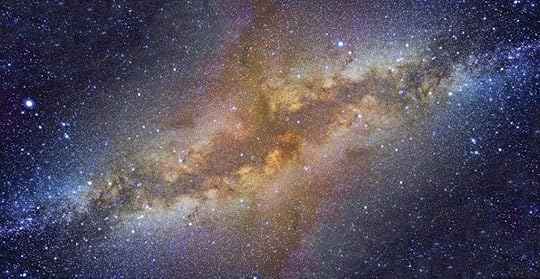
Watch as your star withdraws and returns to its normal place in the beautiful night belly of Nuet. Kiss your hand and extend it toward the star in thanks. When you are ready, walk back down the steps and out the temple doors.
Let your consciousness return to the here and now. Thank Isis in your own words. The rite is ended.
This meditative rite should be done many, many times over the course of your lifetime. Different things will happen at different points in your life and you will discover new things each time. The more you do it, the more you will weave the connection between yourself and your star, a connection that can serve as a guide in this world…and the next.
 NASA says this is a nebula. It looks to me like the astral hand of the soul reaching for its star.
NASA says this is a nebula. It looks to me like the astral hand of the soul reaching for its star.
June 30, 2024
Standing at the Feet of Isis

Several posts ago, I mentioned a particular type of graffiti found at Isis temples in Egypt and in other locations throughout the Mediterranean. These are the images of a foot or feet or footprints that were sometimes scratched on or near Her temple or shrine. Similar feet have also been found carved on separate stone slabs and placed within temples. In Egypt, we find these feet images associated with Isis in Abydos and Philae. Outside of Egypt, we find them in Delos, Chaeronea, Thessaloniki, Maroneia, Rome, and more.
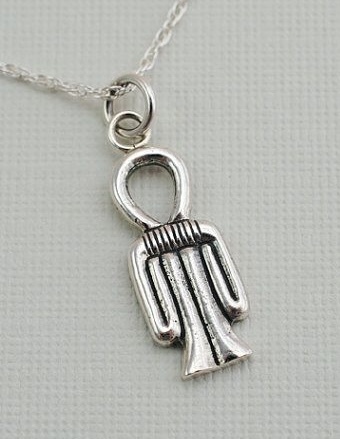 A knot of Isis like the one She took as offering
A knot of Isis like the one She took as offeringIf you’ve ever traveled to a sacred place, you may have been tempted to leave behind an offering or token of some kind to mark your journey. On my own recent pilgrimage to Isis’ temple at Philae in Egypt, it seems I left such a token—if inadvertently. On the boat ride to Her temple island, I was wearing two pieces of jewelry: a knot of Isis and a tiny sistrum. I paid no attention to them at all while we explored Her sacred temple. But on the boat ride back, I had only the tiny sistrum. The knot of Isis must have fallen off sometime during our visit.
Yet the loss made me happy. Why? Because I had had a premonition that something would happen while I was there. I believe that what happened was that Isis accepted the offering that I had unconsciously brought Her. I have since wondered if the Goddess re-gifted it to some other visiting priestess and absolutely made her day, week, and month. I hope so; that’s my fantasy, anyway.
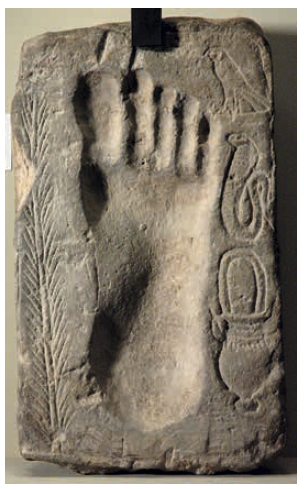 A votive footprint from a temple in the Egyptian Faiyum
A votive footprint from a temple in the Egyptian FaiyumOf course, I would never have etched my footprints or left graffiti on Her temple as some ancient visitors before me had done. I mean, what were they thinking!?! And, in fact, that’s exactly what I’d like to explore today: what were they thinking, and what are those footprints about anyway?
In a general sense, footprints are tangible proof that someone was here; right here—and substantial enough to leave a print. Remember the Ice Age footprints discovered in New Mexico several years ago? They are of a woman and child and they’re the longest continual track of fossilized footprints found to date; they continue for almost a mile. Because of the pace of the footprints and the changing depth of the imprints, researchers can tell something about what may have been happening to those people at that time. Or remember how affecting seeing Buzz Aldrin’s human footprint in the dust of the moon was? Or perhaps you’ve been intrigued by the celebrity footprints (and handprints) outside Grauman’s Chinese Theatre in Hollywood? Like a fingerprint, a footprint uniquely represents the one who made it.
 Etched footprints of (probably) priests of Khonsu on the roof of His temple at Karnak
Etched footprints of (probably) priests of Khonsu on the roof of His temple at KarnakFootprints can often have a spiritual significance, too. Across the world, people have always pointed out what they say are footprints of Deities, heroes, and supernatural beings. Some are natural footprint-shaped indentations in rock, while others are human-created, like the giant God-footprints in Syria’s ‘Ain Dara temple. Such physical evidence is meant to clearly demonstrate the Deity’s Presence. These God-sized footprints may be meant to commemorate a human being’s experience of Divine epiphany. Or their permanence, especially in a temple, may be meant to say, “the Deity is always here.” However we interpret them, there is magic in them.
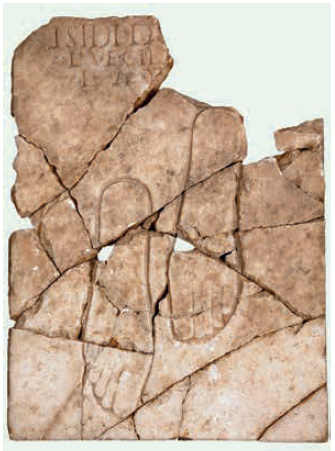 The “walking” footprints from Isis’ Baelo Claudia temple; you can see Her name in Latin in the upper left of the photo
The “walking” footprints from Isis’ Baelo Claudia temple; you can see Her name in Latin in the upper left of the photoIsis is, of course, one of the Deities Who left such evidence of Her Divine Presence in Her temples. We have a limestone slab from Alexandria, Egypt that shows a single, large footprint that has been conveniently labeled for us in Greek: Isidos Podas, “Foot of Isis.” Separate stone slabs like this, incised with a Divine foot or feet, seem to have been an Egyptian thing and is attested for Egypt from at least the 5th century BCE. Similar carved slabs are also found throughout the Mediterranean, and often in temples of “The Egyptian Deities.” During the Hellenistic and Roman periods, “the Egyptian Deities” meant specifically Isis, Serapis, Harpokrates, and Anubis. Sometimes, other symbols related to the Deity are carved along with the foot or feet, or the dedication informs us that it was given to fulfill a vow or “by order of” the Deity.
We sometimes also find votive footprints carved in stone that would then be set into the floor of the temple. In the Isis temple in Baelo Claudia, Spain, the footprints are offset, as if in movement, and seem to lead toward the altar. (I love this.) In this case, the footprints have been interpreted as the path walked by Isis’ priests as they served Her or as the steps of the Goddess Herself as She attends the ceremonies at Her temple. Another small Isis sanctuary near Seville shows similar treatment with the footprints approaching the sanctuary entrance.
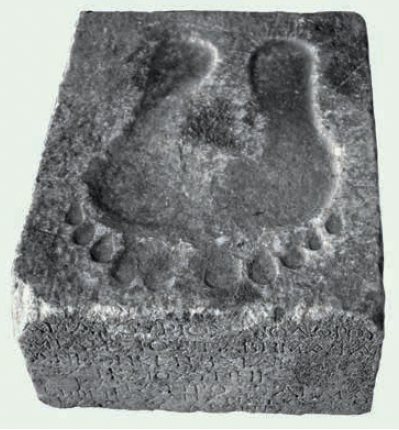 Votive “footsteps” dedicated to Isis Dykaiosyne from the sacred island of Delos
Votive “footsteps” dedicated to Isis Dykaiosyne from the sacred island of DelosFrom the sacred island of Delos in Greece, we have a pair of footprints, labeled as “footsteps” and dedicated to Isis Dikaiosyne, “Isis of Justice,” by “order of the Goddess.” Another set of Goddess-sized footprints from Delos were dedicated to Isis and Anubis by at least three women. From Chaeronea, we have sandalled feet dedicated “following the command of Isis.” We have similar dedicated footprints from the acropolis in Athens and from Thessalonike.
While oversized footprints usually represent Deities, smaller, human-sized ones represent Their human worshipers. The footprint demonstrates the worshiper’s presence before the Deity at Their temple. Some of the earliest examples come from Egypt. We find them not only in temple complexes, but also in hilltop locations, perhaps putting the human closer to the Divine in this elevated position. In Egypt, there are hundreds of examples and they date from as far back as the Old Kingdom. Some were made by visitors to the temples, but many were made in areas—such as the roof—that were inaccessible to anyone but the clergy. Thus it seems to have been a privilege of the priests to be able to put themselves in continual proximity to the Deity of the temple. In fact, the four instances of footprint graffiti found at Isis’ Philae temple come from a single family that served there as priests of Isis. (Researchers also note that some of the footprints from Egypt are found in secular contexts, often made by soldiers, and simply say, “I was here.” Because. Humans.)
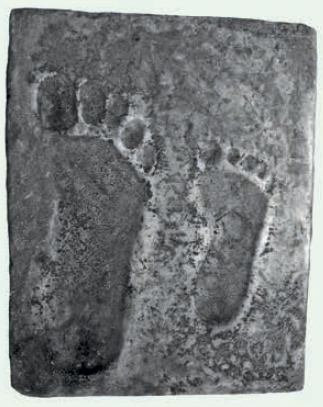 Footprints of the Goddess and Her devotee from the Temple of Isis Locheia in Dion, Greece
Footprints of the Goddess and Her devotee from the Temple of Isis Locheia in Dion, GreeceSometimes we find a larger footprint beside a smaller one, perhaps to represent the Deity and Their worshiper. An example of a set of footprints like these comes from the Temple of Isis Locheia in Dion, Greece. They may be meant to show that the devotee is walking beside Her Goddess. Since Isis Locheia is a protector of women in childbirth and of children, we can surmise that the footprints represent a pregnant woman asking protection from Her Goddess.
We also find a number of these footprint dedications given by now-free, formerly enslaved people. Both Isis and Serapis were known to help manumit slaves through a fictitious “sale” to the Goddess and God.
Later, during the Roman Imperial period, a new kind of “foot” comes into vogue. It is a gigantic 3D sculpture of a Divine foot. A famous example is the Piè di Marmo (“Marble Foot”) that now resides on Via del Piè di Marmo in Rome and which is believed to be a large foot of Isis (or possibly Serapis) from the temples of Isis Campense or the Serapium. These feet are free-standing and not part of a large, lost statue. In other words, the whole Deity is represented by the foot. Scholars believe that this trend, too, first developed in Egypt and was exported to other sanctuaries in the Mediterranean.
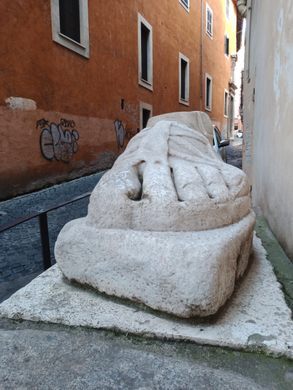 The Piè di Marmo in Rome
The Piè di Marmo in RomeThe concept of representing ourselves or our Deities by footprints—by the traces left behind by our presence or Their Presence—is found worldwide. People everywhere do it and have done so for thousands of years. The many “footprints of Buddha” are just one example from outside the Mediterranean region. They are, I believe, similar in meaning to the prehistoric handprints found in caves from Indonesia to France.
In Egypt, we have Old Kingdom evidence of the idea that “my footprint means I was here” in both secular and sacred contexts. By the New Kingdom, oversized Divine footprints begin to appear. But instead of being etched into temple walls or roofs, they are often carved on separate slabs of stone and dedicated in temples. We begin to see this trend outside of Egypt, too, especially in temples of Isis and Serapis, but also in temples of other Deities in sanctuaries throughout the Mediterranean. Remember the ones at Hekate’s temple in Karia?
For the Isis shrine in my backyard, we purchased two slabs of rock that we intend to have sandblasted with a pair of votive feet, right foot on one, left on the other. This is a project yet to be done, but after looking into this interesting little chapter in the worship of Isis, I’m gonna have to get on that. She needs some footsteps of Her votary—me—leading into Her temple.
June 23, 2024
The Power of Isis
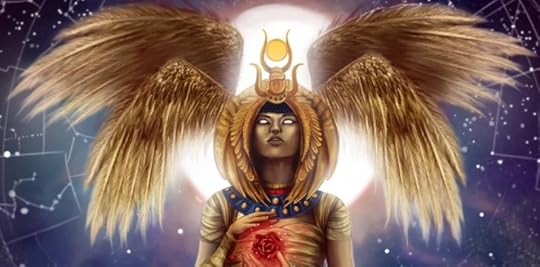
In my own work with Isis over the years, I have come to settle on four qualities that seem to me to capture much of Her “flavor” for me. They are power, wisdom, love, and magic.
When we first come to Isis, we often immediately perceive Her love, flowing out to us, enfolding us in Her sheltering wings. We are warmed in Her love. We rest in Her wings.
Her power reveals itself later.
 The “Isis of Coptos”
The “Isis of Coptos”First, there is Her metaphysical power. This is the power that blows my hair back, makes we want to “kiss the ground before Your beautiful face,” as the ancient texts put it. This power makes me gasp, thrills my body and makes me shiver. Before this power, I can say only, “yes, Goddess.” And rejoice. Sometimes there’s a stupid grin on my face in Her powerful Presence. Sometimes Her power kicks open all my doors, both physical and spiritual and I have no idea what sort of expression might be on my face. Isis often hides this metaphysical power behind Her famous veil, for without the shielding of the veil, Her full Presence could overwhelm us.
But there is another, more earthly, kind of power that She shows us as well. And this is the power of persistence. Plutarch, in his essay On Isis and Osiris, says that Isis serves as an example to those enduring suffering in life. And so She does. As Her myths instruct, each time the Goddess suffers a tragedy, She uses Her power to pick Herself up and go on; and ultimately, to succeed.
 Isis finding Osiris by artist Hoda Hefzy.
Isis finding Osiris by artist Hoda Hefzy.Perhaps this seems a boring power? I don’t think so. For human beings, I believe this power of the Goddess is one of the keys to living. We will all experience pain, failure, death; indeed, some will suffer more than others. But we can all look to the stories of our Goddess passing through these things Herself to find our own power. What’s more, in our times of trouble, we can borrow some of Her strength. She will lend it to us in abundance. She is the fount of power, both mystical and persistent, and She never, ever runs dry. When we are in pain, She will take our hands and She will make us stronger, filling us with Her holy power.
What qualities does Isis manifest in your experience?



